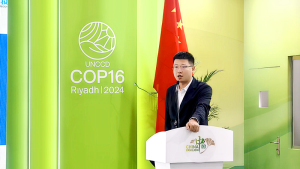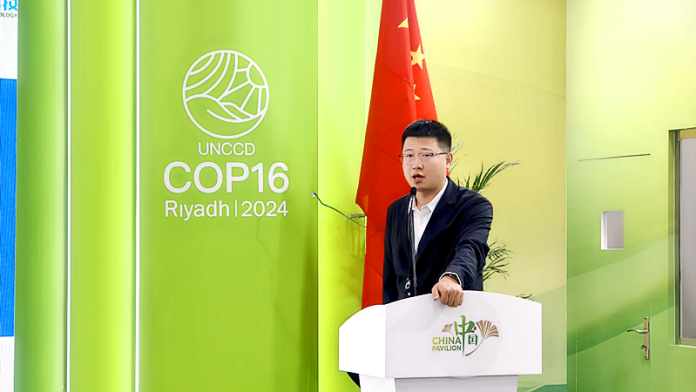[International Energy Network, Live Report] The side event titled “From Arid Zones to Zero-Carbon Industrial Parks: Building Sustainable Energy Industry Systems” was held at the China Pavilion of the 16th session of the Conference of the Parties (COP16) to the United Nations Convention to Combat Desertification in Riyadh on the afternoon of December 11th. This side event was hosted by Center for Energy Transition and Social Development School of Social Sciences Tsinghua University, co-hosted by China Arab Green Development Cooperation Center and China Renewable Energy Engineering Institute and International Energy Network.
This side event will highlight successful practices of zero-carbon industrial parks globally and explore Chinese enterprises’ contributions to developing sustainable energy industries in the Middle East. By leveraging the vast land resources of arid regions, large-scale wind and solar energy projects are being developed while attracting investments in energy-related manufacturing. This approach aims to establish sustainable energy industry systems, contributing to the United Nations’ 2030 Sustainable Development Goals.
During the conference, Gao Sheng,General Manager of Zhejiang Gaoming New Material Technology Co., Ltd, delivered a keynote speech titled “BIPV Transformation and Renewal for Old Industrial Parks” . Gao Sheng introduced BIPV application scenarios, BIPV in buildings, BIPV retrofitting of existing buildings, and pioneering BIPV technologies.

Gao Sheng,General Manager of Zhejiang Gaoming New Material Technology Co., Ltd
BIPV (Building Integrated Photovoltaic) integrates photovoltaic power generation technology with the external envelope structures (such as windows, curtain walls, roofs, etc.) or internal decorative materials (such as ceilings, partitions, etc.) of buildings, achieving a perfect combination of buildings and photovoltaics. This integration not only provides renewable energy generation capabilities but also combines aesthetics, functionality, and durability, achieving a perfect fusion of buildings and energy.
According to Gao Sheng, BIPV predominantly chooses cadmium telluride power generation glass due to its good processability and flexibility, allowing it to be made into various shapes and sizes and easily integrated into various architectural styles. With a high light transmittance (with options ranging from 0% to 60% transmittance), cadmium telluride power generation glass ensures sufficient natural light inside buildings, enhancing residential comfort. The color of the PVB film can also be adjusted through laser scoring, allowing cadmium telluride power generation glass to be customized to meet demand. Additionally, cadmium telluride power generation glass has strong light absorption capabilities under low-light conditions, enabling normal power generation in environments with insufficient illumination such as cloudy and rainy days.
Cadmium telluride power generation glass demonstrates superior characteristics compared to crystalline silicon components. These advantages make cadmium telluride power generation glass an ideal choice for future BIPV applications.
“In the field of architecture, Gaoming’s BIPV photoelectric glass brings many advantages due to its highly customizable features:
On the one hand, through the high customization of BIPV photoelectric glass, light transmittance, colors, patterns, and shapes can be adjusted to perfectly match glass, stone, and aluminum panels, thereby aesthetically integrating BIPV photoelectric glass into the building’s appearance and achieving a seamless connection between building appearance and energy use.
On the other hand, considering the different functional requirements of various locations within buildings, different configuration specifications of BIPV photoelectric glass can be selected to more accurately meet the functional requirements of buildings in terms of lighting, insulation, heat insulation, power generation, and decoration, further enhancing the overall quality and use value of buildings,” said Gao Sheng.
Utilizing renewable energy sources such as solar, wind, and geothermal energy to generate power and provide heating for buildings is undoubtedly an important step towards reducing carbon emissions and moving towards a low-carbon future. Among them, BIPV technology, with its unique advantages, has become a core force driving the development of green buildings.
As an important carrier of economic development, the green transformation of industrial parks is of great significance for achieving sustainable development goals. By widely applying Building Integrated Photovoltaic technology, industrial parks can achieve energy conservation and emission reduction, increase energy self-sufficiency rates, improve economic benefits, enhance park images, and promote technological innovation, among other goals.
Gao Sheng introduced the important role of BIPV in building transformation using the example of Zhejiang Dingsheng New Materials Technology Co., Ltd., which retrofitted a multi-story office building into a near-zero energy consumption and near-zero carbon emission building.
Gaoming redesigned and repackaged the building’s surface materials, shapes, and tones, added green energy, gave the building a new image, and incorporated some symbols not found in the original building, making the building more attractive and reducing energy consumption and carbon emissions.
“By applying BIPV technology to generate clean electricity using solar energy, we can reduce dependence on traditional energy sources, thereby lowering the building’s energy consumption. The electricity generated by BIPV technology is clean and renewable, significantly reducing emissions of greenhouse gases such as carbon dioxide and contributing to addressing global warming. After the retrofitting, the project’s installed capacity is approximately 1.43 megawatts, with an expected annual photovoltaic power generation of 1.4 million kWh, reducing carbon emissions by about 630 tons annually, equivalent to planting 35,000 trees,” said Gao Sheng.
Finally, Gao Sheng expressed that in the future, Gaoming will continue to collaborate with global partners to jointly promote the widespread application of green energy technologies globally, leveraging BIPV technology to assist in retrofitting buildings towards near-zero energy consumption and near-zero carbon emissions.






